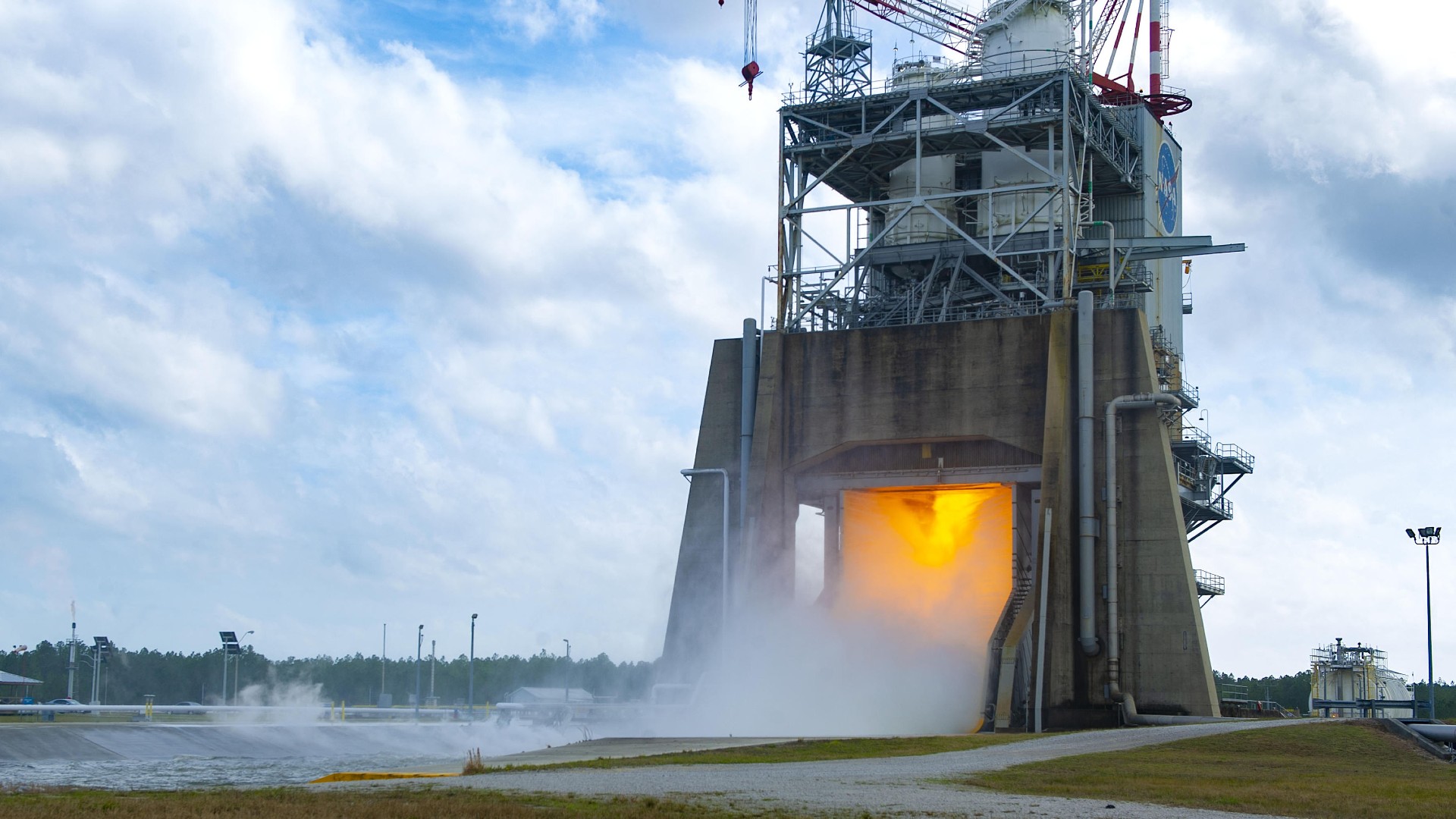Watch NASA test fire new and improved Artemis moon rocket engine (video)
The four engines will provide as much as 2 million pounds of thrust to launch the SLS to orbit.
NASA engineers have hot-fired the redesigned Artemis moon rocket in preparation for future Space Launch System (SLS) flights that will take humanity back to the moon and beyond.
The test of the RS-25 engine was conducted at the Fred Haise Test Stand located at NASA's Stennis Space Center near Bay St. Louis, Mississippi, on Wednesday, Feb. 22. The test is part of a series to support the production of the new RS-25 engines by contractor Aerojet Rocketdyne, the lead Space Launch System engine contractor.
The improved engines are expected to power future Artemis program missions beginning with Artemis 5. Four of these engines were fire simultaneously during the test, generating as much as 2 million pounds of thrust that will one day be used to help launch crewed Artemis missions to the moon.
Related: NASA test fires upgraded rocket engines for future Artemis moon missions (video)

During the test on Wednesday, the RS-25 engine was fired up to a power level of 111%, the same amount of power that would be needed by the SLS to lift the Artemis mission crew module, Orion, and secondary payloads to orbit. NASA fired the engine for 600 seconds, which is 500 seconds longer than the SLS needs to lift the Orion craft and additional payloads to space, the agency wrote in a statement.
The reason for this long-duration hot fire is to allow operators of the RS-25 to test the limits of the engine's performance. This helps provide a safety margin for actual flight operations.
The engines on the SLS currently are upgrades of 16 remaining main engines that remained at the conclusion of NASA's space shuttle program. NASA Stennis began testing the engines in 2015, adding modifications that would be required to fly SLS, the most powerful rocket ever to launch.
Get the Space.com Newsletter
Breaking space news, the latest updates on rocket launches, skywatching events and more!
One of the most impressive aspects of the SLS is the fact is it is designed to be upgradable. With this in mind, in 2019, NASA contracted Aerojet Rocketdyne to produce completely new RS-25 engines for SLS missions beyond Artemis 4.
Created with advanced manufacturing techniques such as 3D printing that reduced the cost and timescale of development, the engines hit initial developmental testing in 2020.
On Feb. 8, the first real test of the first completed upgraded RS-25 engine was conducted as part of a 12-test program which will ensure Aerojet Rocketdyne is ready to produce the engines for future missions. Each of these subsequent engines will be tested at NASA Stennis by a combined team of NASA, Aerojet Rocketdyne, and Syncom Space Services operators.
Follow us on Twitter @Spacedotcom or on Facebook.
Join our Space Forums to keep talking space on the latest missions, night sky and more! And if you have a news tip, correction or comment, let us know at: community@space.com.

Robert Lea is a science journalist in the U.K. whose articles have been published in Physics World, New Scientist, Astronomy Magazine, All About Space, Newsweek and ZME Science. He also writes about science communication for Elsevier and the European Journal of Physics. Rob holds a bachelor of science degree in physics and astronomy from the U.K.’s Open University. Follow him on Twitter @sciencef1rst.
-
Aldo Giovanny Ruiz The engine with the highest performance and thrust, which would you say it is? :rolleyes:Reply -
TroyH The F1 Rocketdyne engine(s) designed 60+ years ago are more powerful than these newer Artemis engines. One F1 engine makes almost 2 million pounds of thrust (~4 Artemis engines) WTH 🤔 Why build something new that needs 4 engines when you already have a proven entity (0 failures)Reply -
Unclear Engineer The F1 burned kerosene fuel. The Artemis rockets use hydrogen fuel. So, not directly interchangeable.Reply
Why the Artemis program uses hydrogen fuel is the question. For one thing, these are repurposed rocket engines from the Space Shuttle, so the real question is why did the Shuttle us liquid hydrogen?
SpaceX has decided to go with liquid natural gas/methane. And to use 33 rocket motors on its Super Heavy first stage. The goal there is to have a fuel that is easier to handle than liquid hydrogen, so that the reuseable stage can get turned around for reuse quickly. And the use of so many rocket engines in the SpaceX design allows for the vehicle to achieve orbit even if a couple of the engines malfunction and need to be shut-down after liftoff.









